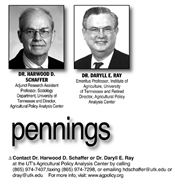|
The Bruce Gardner Precept

The difference between us and many other agricultural economists is that over the years we have developed our agricultural policy proposals based on the economic characteristics of aggregate crop agriculture:
• The low price-elasticity of supply,
• The low price-elasticity of demand,
• The fixity of resources,
• Agriculture has the ability to create both positive and negative externalities, and
• Farmers operate between to great power concentrations:
o They are faced with oligopolies or monopolies when they purchase their inputs, and
o They are faced with oligopsonies or monopsonies when they sell their products into the marketplace.
Most other agricultural economists seem to us to be operating on what we respectfully call the Bruce Gardner Precept. Bruce was an outstanding and highly revered agricultural economist, whom Daryll was privileged to know and call a friend. Bruce was professor, department head, or dean at the University of Maryland for over twenty years. For four decades, Daryll used Bruce’s ground-breaking research in his classes.
In 2006 Daryll and Bruce made presentations to the Agricultural Task Force of the Chicago Council on Foreign Relations. Bruce went first. When he finished, Daryll gave his talk about the two low price-elasticities and other characteristics of the aggregate market for storable crops.
When Daryll sat back down next to Bruce, Bruce leaned over and said to Daryll, “I agree with your analysis of the problem, I just don’t like the implication of it when it comes to policy.”
While many-to-most agricultural economists acknowledge the economic characteristics described in the first paragraph, they, too, are hesitant to design agricultural policies that take these characteristics into account.
The result is policy proposals that put elastic bandages on perpetually-open farm income wounds. These bandages are usually “income back-fill programs” that end up costing far more than traditional farm policies that more closely consider the economic characteristics of aggregate agriculture.
One thing this means is that we often look at the same information as other agricultural economists but see different implications or come to different conclusions. A clear example is our contrasting view to that of farmdocdaily agricultural economists who write about the declining US export share of storable agricultural commodities like corn, soybeans, and wheat. We agree on the data.
We disagree on the data’s implication for US agricultural policy. (In this case one practical issue is: where would the acres come from that would allow us to maintain the export market shares of the 1970s or even the 1990s?)
But the major analytical focus is on the magnitude of the interaction between agricultural policy and the US share of row-crop exports.
Our analysis is that history and recent experience suggest that declining export market shares are inevitable, regardless of policy direction. If anything, the occasional explosive price run-ups and general price instability of recent policies have accentuated the downward trend in export shares compared to traditional farm programs.
In general, it is our view that if one doesn’t account for the economic characteristics of crop agriculture, one is confined to developing various proposals that look like they are legitimate but end up being schemes to deliver inadequate amounts of money to farmers.
For instance, we agree that crop insurance can play a vital role in stabilizing farm income when there are weather-related production problems. In addition, it is far superior to ad hoc disaster programs that miss localized weather-related problems.
But when people describe crop revenue insurance as “countercyclical,” we beg to disagree. The price component for crop insurance indemnities is typically based on a futures price for a particular month before the crop is planted. That means when prices are high, the protection is great or even excessive. But when prices are low so is the level of protection, just at the time farmers need it the most.
Because of the way price is currently determined for crop insurance policies, it is anything but countercyclical. Crop insurance overpays when prices are high and offers little help when prices are low.
The same can be said for ARC and PLC which use inadequate reference prices as well as a host of other alphabetic programs that have used various gimmicks instead of using the cost of production or a high percentage of the cost of production in their calculations.
From our perspective, we need to develop programs that are unused in those episodic but short periods of time when prices are high but provide farmers with support at a level just below the full cost of production when prices are low. ∆
DR. HARWOOD D. SCHAFFER: Adjunct Research Assistant Professor, Sociology Department, University of Tennessee and Director, Agricultural Policy Analysis Center
DR. DARYLL E. RAY: Emeritus Professor, Institute of Agriculture, University of Tennessee and Retired Director, Agricultural Policy Analysis Center
|
|